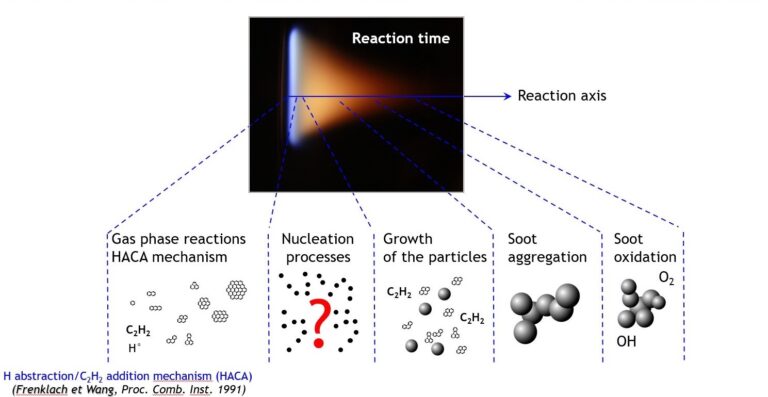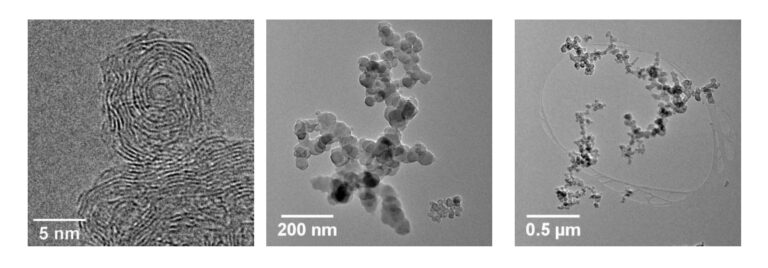Credits : France SIMONET/IRCELYON/CNRS Photothèque
Topic 1 :
Synthesis, nucleation process and characterisation of soot at source
A complex object from its formation
The nucleation stage, i.e. the stage corresponding to the transformation of gaseous species into soot particles, is crucial for the study of soot since it directly conditions its optical and physico-chemical properties. Once the first nuclei are formed, they grow by chemical surface growth reaction, by condensation of gaseous species, in particular polycyclic aromatic hydrocarbons (PAHs), on the soot surface and by coagulation. The primary particles formed in this way end up forming “fractal” agglomerates.
It is therefore conceivable that, depending on the mode of combustion and the nature of the fuels (i.e. the mode of synthesis), the characteristics of the soot differ, such as their morphology (shape of the aggregates, size of the primary spherules, rate of overlap between particles), their crystalline or amorphous nature, their chemical composition, their reactivity with the medium or finally their optical properties. Moreover, these characteristics evolve as a function of the reaction time in the flames. Nevertheless, their determination is a crucial issue for a detailed elucidation of the soot formation, growth and oxidation processes.
Two major objectives are emerging in this context: to master the synthesis and nucleation of soot particles with targeted properties and to make progress in the development, sharing and implementation of soot characterisation methods. In this context, the coupling of diagnostics requiring the bringing together of laboratories with complementary skills in aerosol metrology and in understanding the physico-chemical mechanisms of the formation of these particles is a promising avenue.
Furthermore, synthetic soot from, for example, a CAST generator, is an interesting object of study for the development of techniques characterising its properties as it produces soot particles with very specific properties in a reproducible manner. However, it is important to bear in mind that the soot produced in this way is not fully representative of real soot, whose properties are the result of a complex reaction history reflecting the entire formation process.
In addition, the formation of soot analogues has been known for many years in cold plasmas, electric arcs and laser ablation. As in combustion processes, the role of PAHs is frequently reported, their formation coming from ion-neutral or ion-ion recombinations. The GDR has enabled fruitful interactions to be established between the “combustion” and “cold plasma” communities. These interactions have also been extended to the problem of the formation of carbonaceous residues during violent electrical discharges in the atmosphere or during meteorite re-entries.


